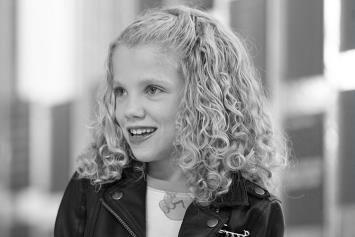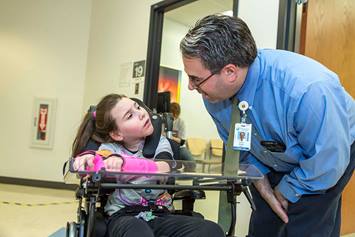Cerebral Palsy (CP)
Cerebral palsy is a group of disorders that affect movement, muscle tone, balance, and posture.
Cerebral Palsy (sera brul PAUL zee) (CP) is an injury or abnormality of the developing brain that affects movement. This means that something happened to the brain or the brain did not develop normally. The injury or abnormality that caused CP does not get worse over time. As your child grows, function may change. This does not mean the brain is getting worse.
It is estimated that between 8,000 and 10,000 babies born each year will have CP.
Causes
An injury or abnormality of the developing brain is the cause of CP. Sometimes infection, blood clots, prematurity, genetic problems, or lack of oxygen can cause CP. Often the cause is not known. There is no known cure for CP but symptoms can be managed with stretching at home, physical therapy, occupational therapy, speech therapy, bracing, medicine, and surgery.
Signs and Symptoms
CP can be described by the number of limbs involved.
-
Quadriplegic (kwa drha PLEE jik): Both arms and both legs (4 limbs) are affected. This does NOT necessarily mean that the child cannot move his arms and legs at all, just that both arms and both legs are involved.
-
Hemiplegic (heem uh PLEE jik): One arm and one l leg (2 limbs) on the same side are affected.
-
Diplegic (dye PLEE jik): Both legs are involved.
-
Triplegic (try PLEE jik): Both legs and one arm (3 limbs) are affected.
CP can also be described by the type of movement pattern of the involved limbs.
-
Spastic (SPAS tic): Spasticity is a velocity-dependent resistance to movement. This means that the faster you try to stretch a joint, the more resistance you feel. The child with CP has increased muscle tone and muscles may feel “tight” or “stiff”.
-
Hypotonic (hi po TAHN ick): This means that the child with CP has low muscle tone. The limbs may appear “floppy”.
-
Athetoid (ATHE toyd): This means that the child with CP has repetitive twisting and turning of the limbs. These are subtle movements with no purpose. Children with CP often have trouble controlling their movements.
-
Most children with CP have some overlap in types; however, usually one type is most notable. For example, a child with spastic CP may have increased muscle tone in the limbs but have low muscle tone (hypotonia) of the neck and trunk muscles.
Diagnosis
-
Missing developmental milestones may be the first sign that development is delayed. Missing milestones in motor (movement) development might be the first sign that a child may have cerebral palsy. Normal development usually happens in a “range” of ages. For example, a child who is developing normally will walk by himself between 9 and 15 months.
-
Some children with cerebral palsy may meet milestones early. For example, a child with one-sided (hemiplegic) CP may be able to roll earlier than 6 months because one side is stiff. If you feel that your child is missing milestones, talk to his pediatrician.
-
CP is diagnosed by what your child’s doctor finds during the exam. The diagnosis is made based on both your child’s medical history and physical exam. Your child’s doctor may also have an MRI done to check your child’s brain.
-
The MRI will show what the parts of the brain look like, not what your child is able to do. Your child’s doctor will be able to see what he or she can do during the exam. Your child may still be diagnosed with CP, even if the MRI is normal.
-
The MRI can show the structure of the brain, but not how well the brain is working. Children with CP have a problem with how the brain works.
-
Although the diagnosis of CP is based on changes in movement, injuries and abnormalities of the brain may have other effects. Some children with CP may have changes in:
-
Seizures
-
Behavior
-
Sensation (vision, hearing, etc.)
-
Perception (understand and use sensory information)
-
Cognition (the ability to pay attention and learn)
-
Communication (the ability to understand and use language)
-
Treatment
Each child with CP is unique. Treatments are focused on your child’s needs and physical challenges.
-
Home stretching: Stretching helps the muscles to be more relaxed and less spastic. It can also help increase how much your child can move his or her body. Stretching is most effective if done daily.
-
Therapy: Physical, occupational, and speech therapy help your child improve speech and movement.
-
Bracing: Braces are used to support and position a joint. This helps to move the joints in the right way. It keeps the joints in the right position to prevent joint injury. Braces are named for the body part they support.
-
Ankle Foot Orthosis (AFO) is a brace that supports the foot and ankle. The brace comes up just below the knee.
-
Superior Malleolar Orthosis (SMO) is a brace that supports the foot and heel bone. The brace comes up just over the ankle.
-
-
Medicine: Most medicine used for CP is used to lessen spasticity. Your child’s doctor will decide what medicines are best. Some of these medicines are:
-
Baclofen (Lioresal)
-
Diazepam (Valium)
-
Botulinum toxin (Botox)
-
Dantrolene (Dantrium)
-
FAQs
Will my child be able to walk?
Each child with CP is different. Because CP represents a very wide range of individuals, it is difficult to tell what a particular child with CP will be able to do in the future. When your child is around five years old, a doctor can better decide function, but this is never certain. Some diplegic children don’t walk until 4 to 6 years of age.
What about contracture and spasticity?
Contractures can be viewed as if the muscle is a short piece of rope; it does not matter how fast you try to stretch the muscle. It stops in the same place. A contracture is a fixed shortening of the length of a muscle. Contractures frequently occur when muscles are not stretched out and become too short to allow a joint (such as the ankle or knee) to be fully extended. Contractures often become noticeable after periods of growth because bones typically grow first and muscles get pulled along.
Spasticity can be viewed as if the muscle is a spring; the faster you stretch the muscle the more resistance you have and the quicker the muscles stops. Stretch the muscle slower so you can stretch the muscle out farther.
It is important to decide whether contractures or spasticity is present because treatments for one will not help the other. The main treatments for contractures are stretching, bracing, and surgery. It is important to do daily stretching as instructed by your doctors and therapists to avoid surgery.
Team Members
There are many people who will help take care of your child. Individual specialists or a team of providers may be available to help you with your child’s lifelong care. A team provides a holistic view of your child’s needs.
Administrative Assistant: An Administrative Assistant supports the team with scheduling appointments, phone call triage, and other administrative duties.
Care Coordinator: A Care Coordinator helps parents locate and coordinate the services their child may need. A family-centered care plan is developed.
Medical Assistant: A Medical Assistant supports the team by performing tasks and procedures such as getting height and weight measurements, checking patients' vital signs, and giving medicines and injections.
Nurse: A Nurse is trained to provide a thorough assessment and work out a plan to help your child stay healthy and well. A Nurse coordinates care to help improve a child’s outcome.
Nutritionist: A Nutritionist is trained to decide the appropriate calorie and food needs of a child.
Occupational Therapist: An Occupational Therapist works on activities of daily living (ADLs), fine motor skills, handwriting, coordination, and strengthening of the upper limbs (arms). ADLs include bathing, dressing, and eating.
Orthopedist: An Orthopedist is a medical doctor who is trained in surgeries on the bones, joints, and muscles. For children with CP, an Orthopedist evaluates the benefits of surgery for muscle lengthening, protection of joints for subluxation and dislocation, joint reconstruction, and spine alignment for improving posture.
Orthotist (Or THO tist): An Orthotist is trained in making braces such as AFOs.
Pediatrician: A Pediatrician is a medical doctor who is trained in the care of children. For children with CP, a Pediatrician provides diagnosis and management of the medical issues all children have such as colds as well as issues more common in CP such as constipation. The pediatrician will also check for developmental milestones. Often, the pediatrician provides a medical home for the child and looks at the “big picture.”
Physiatrist: A Physiatrist (fizz EE at trist) or Physical Medicine and Rehabilitation (PM&R) physician is a medical doctor who is trained in improving function. For children with CP, a Physiatrist may evaluate and manage spasticity; determine the need for and prescribe medical equipment to facilitate care, safety, and independence; and evaluate the need for, prescribe, and guide therapy activities.
Physical Therapist: A Physical Therapist works on movement, balance, coordination, and strengthening of the lower limbs (legs) to help the child with CP increase his or her independence and mobility.
Social Worker: A Social Worker is trained in advocacy, linkage, and support to help improve the wellbeing of children with CP and their families.
Speech Language Pathologist: A Speech Language Pathologist works on language skills, communication, vocalization, and swallowing. For children with CP, the muscles of speech may be involved. A child may work on non-spoken ways of communication such as sign language and devices to enhance communication. Always focus on what your child can do. Help your child work toward doing the best he or she can!
Helping Hands Patient Education Materials
Written and illustrated by medical, nursing and allied health professionals at Nationwide Children's Hospital, Helping Hand instructions are intended as a supplement to verbal instructions provided by a medical professional. The information is periodically reviewed and revised to reflect our current practice. However, Nationwide Children's Hospital is not responsible for any consequences resulting from the use or misuse of the information in the Helping Hands.
HH-I-220 | ©2002, 5/02, revised 5/14, Nationwide Children’s Hospital


